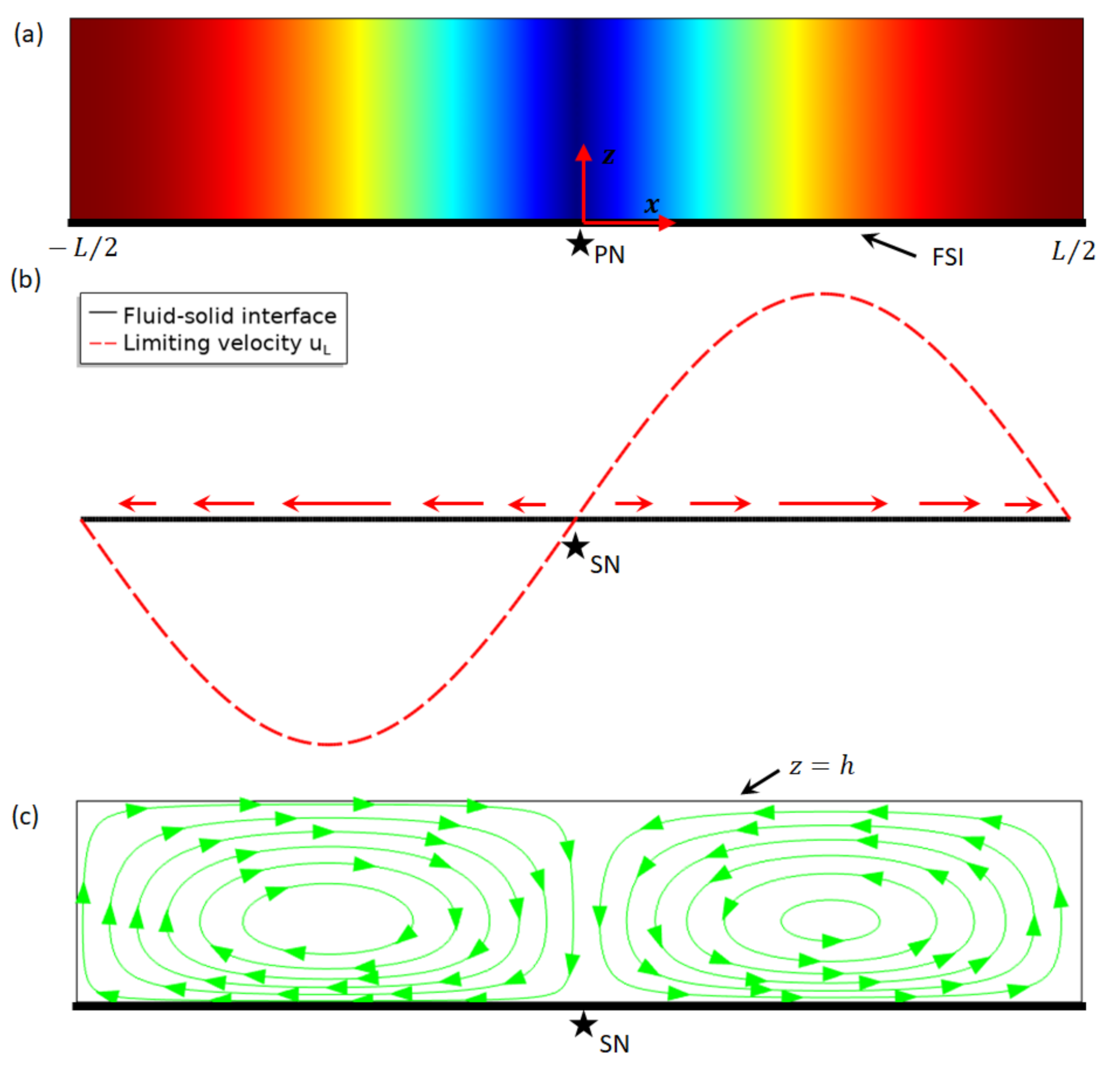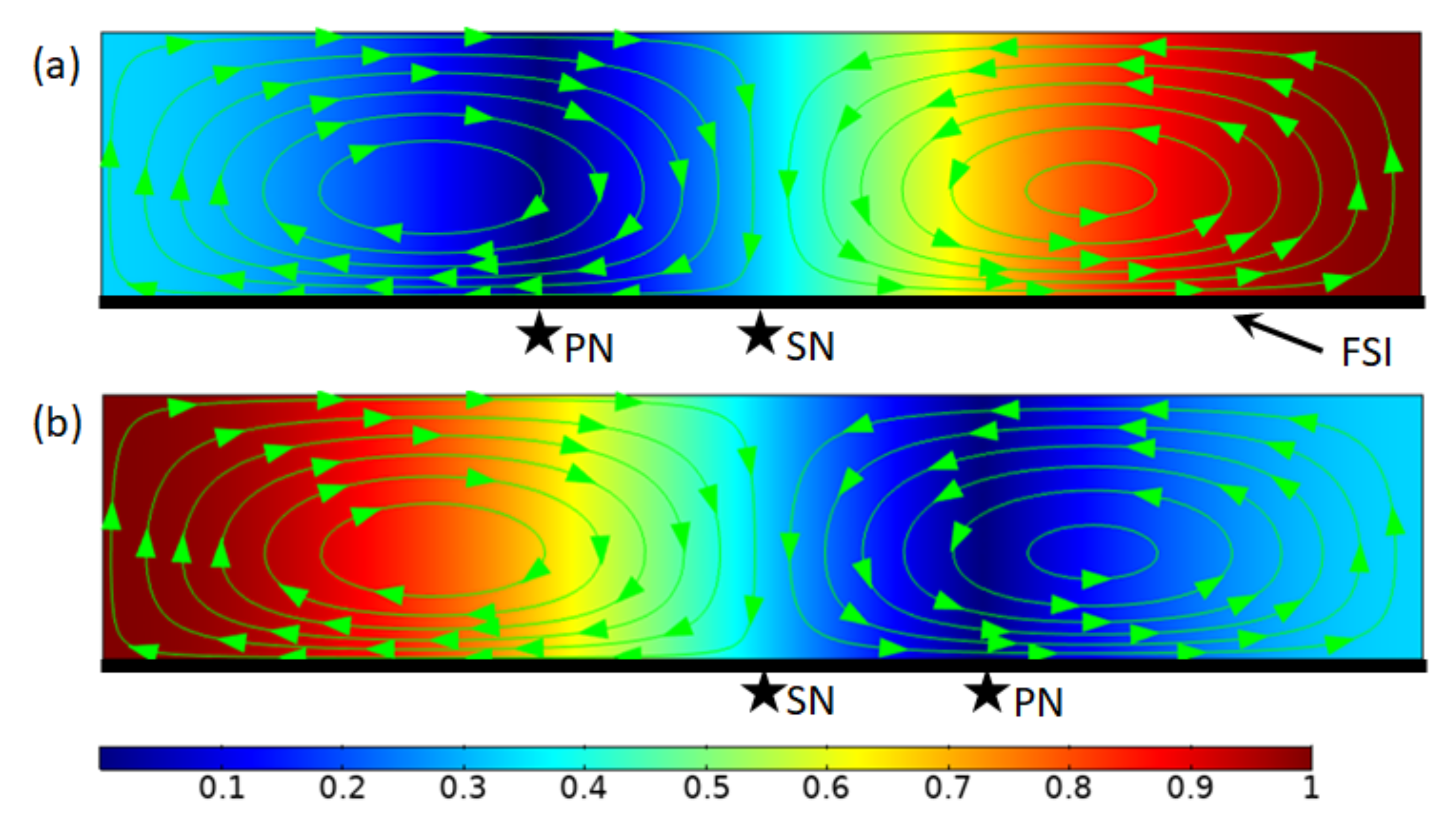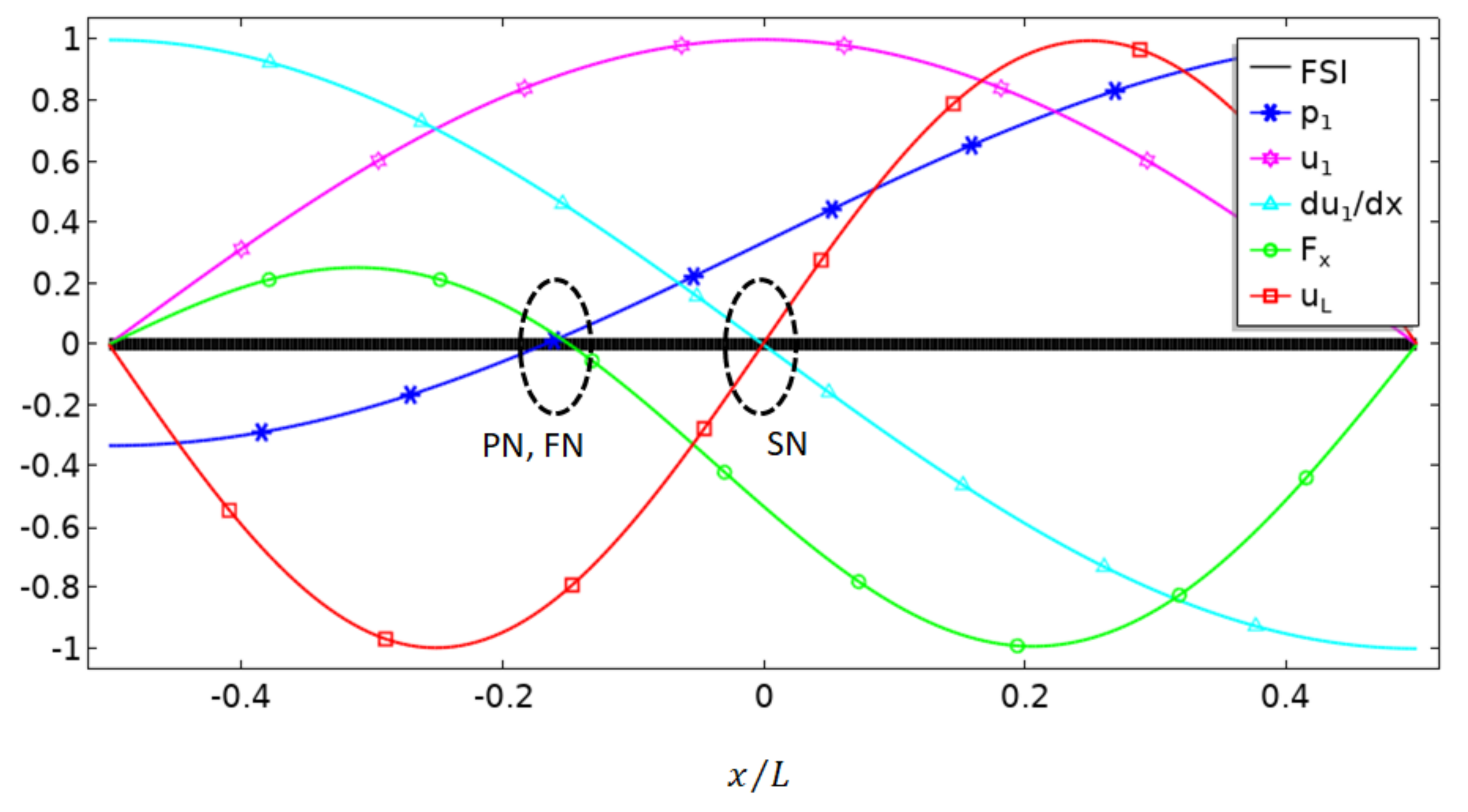1. Introduction
Acoustic streaming is the steady flow driven by acoustic energy dissipation in a viscous fluid. The acoustic energy dissipation in a fluid could occur from two different mechanisms, dissipation in the boundary layers and attenuation in the bulk of the fluid [
1]. The resulting streaming from the former case is known as boundary-driven acoustic streaming, which is usually observed in standing wave fields near walls or suspended objects, while the streaming produced by the latter case is called ‘quartz wind’ or Eckart streaming [
2], which is typically observed in the bulk of channels much larger than the acoustic wavelength [
3]. Understanding the driving mechanisms of acoustic streaming and its variations is important for the design of acoustofluidic devices to enhance or to suppress its effect for lab-on-a-chip applications [
4], such as heat and mass transfer enhancement, microfluidic actuation, sensing, sonoporation and drug delivery, and particle manipulation.
In most micro-acoustofluidic systems of interest where standing waves are typically generated, the acoustic streaming fields are generally dominated by boundary-driven acoustic streaming. As early as 1787, the German physicist Chladni [
5] observed that randomly distributed fine particles on a vibrating metal plate could move to the antinodes, which was later studied by Faraday [
6], who found that it was due to air currents in the vicinity of the plate, i.e., the boundary-driven acoustic streaming. Theoretical analysis on boundary-driven streaming was initiated by Rayleigh [
7], who presented an analytical solution for acoustic streaming between two infinite parallel plates in a one-dimensional (1D) standing wave field. Rayleigh found that in the standing wave direction two streaming vortices per half-wavelength could be generated in each half channel, which is now known as outer acoustic streaming or Rayleigh streaming. After that, a series of modifications have been developed for particular cases [
8,
9,
10,
11,
12,
13,
14], which have paved the fundamental understanding of acoustic streaming flows. While classical Rayleigh streaming patterns have been widely studied in the literature, in the last decade, the mechanisms behind some new (i.e., those that cannot be explained by Rayleigh’s classical theory) outer acoustic streaming patterns have been explored, such as the transducer-plane streaming [
15,
16,
17], which generates streaming vortices in planes parallel to the driving boundary, and the modal Rayleigh-like streaming [
18], in which vortices have a roll size greater than the quarter wavelength of the main acoustic resonance. These aforementioned analyses (and others) on boundary-driven acoustic streaming, starting from Rayleigh to today, have largely focused on those generated in fluid channels or surfaces of rectangular [
19] or circular [
20] cross-sections where symmetric acoustic resonances (i.e., those with equal magnitude of acoustic pressure crests and troughs) are excited.
In this work, we investigate the outer acoustic streaming fields near a fluid–solid interface (FSI) by combining the basic theory of acoustofluidics and the limiting velocity method. A generalized standing wave field either symmetric or asymmetric to the acoustic pressure node is considered. We verify numerically the outer acoustic streaming in the symmetric case with the classical theory of Rayleigh streaming, and discuss the outer acoustic streaming patterns in various asymmetric acoustic resonances. Our analysis of outer acoustic streaming in asymmetric acoustic resonances elucidates fundamental physical aspects and further has potential applications in micro- and nanoparticle manipulation.
2. Mathematical Model
In micro-acoustofluidics systems of particular interest where standing waves are typically excited, the acoustic streaming field that has received more attention than any other is that which arises from acoustic dissipation near FSIs, which, in most cases, could disturb the movements of particles (especially those of nano size) induced by the acoustic radiation force. Here, we aim to analyze and compare this type of acoustic streaming driven by symmetric and asymmetric acoustic resonances. The basic acoustic streaming equations have been presented in the
Appendix A.
We assume that the time variation of each of the first-order acoustic quantities is sinusoidal with
, and let
(and the components of
) be represented as the real part of a complex value with time factor
Based on this relation, we consider here a generic 1D standing wave field in the
-direction, where the distribution of acoustic pressure is given by
here,
is the wave number with
being the acoustic wavelength,
(with
) is the magnitude of pressure shift, which could be potentially influenced by the geometry of the fluid channel, and
is the acoustic pressure amplitude for the symmetric case: A symmetric 1D standing wave field that has same magnitude of pressure peaks and troughs is obtained for
.
Here, outside the boundary layer, the first-order acoustic velocity is irrotational and has only an
-component. Following the acoustic pressure distribution described in Equation (1), the
-component first-order acoustic velocity field can typically be determined using the linearized Euler’s equation, i.e.,
, and is given by
where
is the sound speed in fluid. This equation is applicable to conditions where the magnitude of the acoustic velocity is small compared with the sound speed in the fluid, i.e.,
.
Here, for a 1D standing wave in the
-direction of fluid channel, since
,
and their derivatives are zero, the expression for the
-component limiting velocity (Equation (A12)) reduces to
and the
-component limiting velocity
. For a pure imaginary expression of acoustic velocity derived in Equation (2), Equation (3) further reduces to
, from which it can be seen that the direction of
is that in which the magnitude of
decreases. Moreover, it also indicates that it is the product of the acoustic velocity and its spatial gradient rather than either of them that determines the magnitude of limiting velocity.
Hence, by substituting Equation (2) into (3), the limiting velocity that drives the outer acoustic streaming field for the generalized 1D standing wave case presented in Equation (1) is obtained, which follows
It is interesting to notice that the limiting velocity that drives the outer acoustic streaming field is independent of the pressure shift .
3. Results and Discussion
We now take up the outer acoustic streaming flows associated with a 1D standing wave over a FSI, assuming a slip-velocity condition at the boundary. As shown in
Figure 1a, a FSI located at
was considered. We let the first-order acoustic pressure field be given by Equation (1) in the near field of the FSI in the range
(with
and
are periodic conditions), which is constant in the
-direction.
The special case
was firstly considered. Without a pressure magnitude shift, as plotted in
Figure 1a, it presents a symmetric standing wave with equal magnitude of pressure crests and troughs. The corresponding limiting velocity distribution over the FSI was plotted in
Figure 1b. It can be seen that the limiting velocity (and the outer acoustic streaming presented below) and the acoustic pressure share the same location of nodes (denoted by PN and SN, respectively). On the slip-velocity boundary (
, where the subscript in
indicates the velocity on the boundary), the limiting velocity points from the pressure node to the adjacent antinodes (see arrows). As a result, continuous outer streaming flows could be driven by the limiting velocities near the slip-velocity boundary and for mass conservation (i.e., the total amount of fluid is constant) return flow must occur and vortices could be formed in a confined chamber.
Figure 1c shows the outer acoustic streaming vortical flow when a slip condition (
) was applied to the top boundary
. Two vortices per half acoustic wavelength were generated in the standing wave direction (i.e.,
), while the streaming vortex pattern in the
-direction is dependent on the boundary condition in the far field in the
-direction (e.g.,
), which could be a nonslip (
), slip, slip-velocity or symmetric condition, determined by the configuration of the real experimental acoustofluidic device. For example, in a rectangular channel which contains another slip-velocity boundary at
(or a symmetric condition at
), two outer acoustic streaming vortices (symmetric to
) could be generated between the two parallel slip-velocity boundaries; that is, by symmetry a similar outer streaming pattern to that presented in
Figure 1c exists in the other half of the channel (in the range
). This type of boundary-driven acoustic streaming generated between two parallel walls which are at
and
in a symmetric 1D standing wave field is the well-known Rayleigh streaming.
However, for the asymmetric cases, i.e.,
, it was found that the acoustofluidic effects and their relations could be vastly different. As shown in
Figure 2, two cases with, respectively,
and
are presented and compared. It can be seen that the resulting outer acoustic streaming (solved with slip-velocity boundary at
and a slip condition at the top boundary
) is identical for these two cases. Moreover, although still two outer acoustic streaming vortices are generated in the half-wavelength in the
-direction, it is interesting to notice that the acoustic streaming node (i.e., the dividing point for limiting velocities) for both cases stays at the channel center rather than at the pressure nodes, different from the situation seen in symmetric acoustic resonances. This, however, is easy to understand from the expression of the limiting velocity; that is, the explanation lies in the fact, to be demonstrated in more detail later, that the magnitude of pressure shift
is unrelated to the distribution of the
-component limiting velocity (see Equation (4)), which thus has no effect on the outer acoustic streaming pattern.
Figure 3 plots the distributions of various acoustofluidic fields for a particular case
, from which we aim to obtain further insight into the mechanism of boundary-driven acoustic streaming and to illustrate why the location of limiting velocity nodes (or outer streaming nodes) is independent of
in asymmetric acoustic resonances and how it could affect acoustophoresis of particles in a microfluidic channel. The square-line in
Figure 3 plots the distribution of normalized limiting velocity in
, showing that its node (value of zero or dividing point) locates at
(i.e., the center of the slip-velocity boundary), which is explained by the term
in its expression. Moreover, it is worthy of note that, as shown in Equation (4), this distribution is independent of magnitude of pressure shift and thus is valid for any value of
. This relation can also be obtained from alternative explanations. Since the derivative of
with respect to
does not contain the term
, both
(star-line in
Figure 3) and
(triangle-line in
Figure 3) are independent of
. The limiting velocity
, which is proportional to the product of
and
(see Equation (3)), is zero when any of these two values reaches zero, and thus we have
at the center
for zero value of
in
(marked as SN in
Figure 3).
For the acoustic pressure and velocity distributions presented in
Figure 3, the corresponding distribution of
-component acoustic radiation force on suspending particles in water over the FSI was plotted in
Figure 3 (circle-line), which was calculated using the Gorkov potential [
21],
where
(
) is particle radius,
and
are the time-averaged kinematic and potential energy density,
and
are the density of the particle and fluid,
and
are the sound speed in particle and fluid. As shown, the acoustic radiation force tends to move rigid particles towards the acoustic pressure node, which is similar to the case seen in symmetric acoustic resonances. As known, in an acousto-microfluidic channel, the combination of acoustic radiation force and acoustic streaming-induced drag force plays a vital role in particle acoustophoresis. As discussed above, we see spatial separation of acoustic radiation force and limiting velocities (or outer acoustic streaming flows) in asymmetric acoustic standing wave fields, indicating that it should be possible to build up different asymmetric acoustic resonances to obtain different groups of acoustic radiation force and acoustic streaming-induced drag force.








